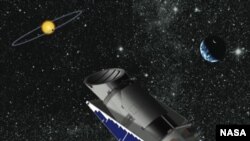After being declared inoperable last year, NASA’s planet-hunting space telescope Kepler has been given a second life.
NASA said Friday that for the next two years, it will fund a mission for the telescope. The new mission is known as K2 and will let the telescope continue to search for new exoplanets and active galaxies.
Last year, NASA said the telescope had been crippled by the failure of a second mechanical reaction wheel that helps keep it pointed. The telescope was launched with four wheels and needs at least three of them to keep it aimed precisely at distant stars.
NASA engineers say they have found a way to use solar radiation pressure, together with the remaining functional wheels, to keep the spacecraft stable enough to continue observing distant stars.
Kepler was launched in March 2009 and positioned in an orbit around the sun with a mission to look for Earth-like planets in the constellations Cygnus and Lyra. The $600 million spacecraft identified 130 planets with additional 2,740 candidates.
Since the stars are thousands of light years from Earth, the precise pointing of the Kepler’s instruments is of critical importance. The planets cannot be seen, but their presence can be calculated from the dip in the light of their stars when other planets pass in front of them.
After analyzing previously collected data, NASA scientists announced in April that the telescope found the first Earth-size planet orbiting a star in the so-called ‘habitable zone.’
NASA said Friday that for the next two years, it will fund a mission for the telescope. The new mission is known as K2 and will let the telescope continue to search for new exoplanets and active galaxies.
Last year, NASA said the telescope had been crippled by the failure of a second mechanical reaction wheel that helps keep it pointed. The telescope was launched with four wheels and needs at least three of them to keep it aimed precisely at distant stars.
NASA engineers say they have found a way to use solar radiation pressure, together with the remaining functional wheels, to keep the spacecraft stable enough to continue observing distant stars.
Kepler was launched in March 2009 and positioned in an orbit around the sun with a mission to look for Earth-like planets in the constellations Cygnus and Lyra. The $600 million spacecraft identified 130 planets with additional 2,740 candidates.
Since the stars are thousands of light years from Earth, the precise pointing of the Kepler’s instruments is of critical importance. The planets cannot be seen, but their presence can be calculated from the dip in the light of their stars when other planets pass in front of them.
After analyzing previously collected data, NASA scientists announced in April that the telescope found the first Earth-size planet orbiting a star in the so-called ‘habitable zone.’








